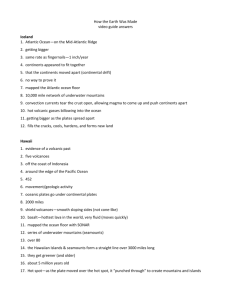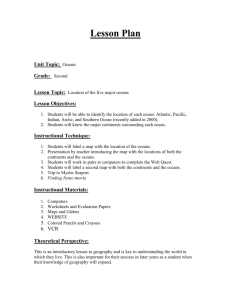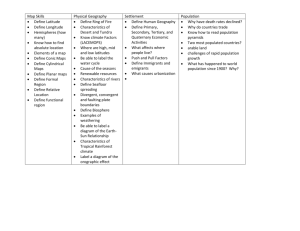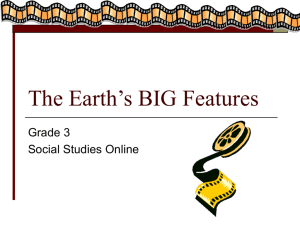Chapter two
advertisement
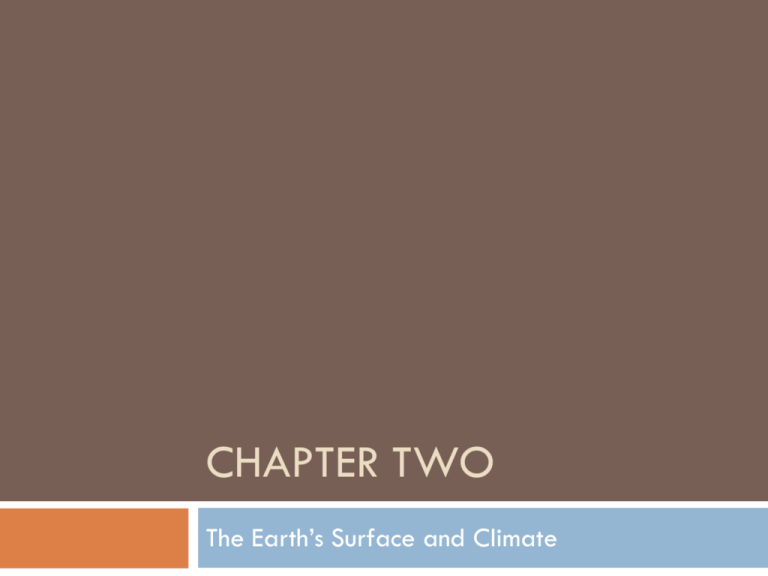
CHAPTER TWO The Earth’s Surface and Climate Psalm 104:1-5 I praise you, LORD God, with all my heart. You are glorious and majestic, dressed in royal robes and surrounded by light. You spread out the sky like a tent, and you built your home over the mighty ocean. The clouds are your chariot with the wind as its wings. The winds are your messengers, and flames of fire are your servants. You built foundations for the earth, and it will never be shaken. I. The Earth’s History God’s Work on the Earth- 4 phases Creation- Genesis 1 Flood- Genesis 7 Current World Future World II. The Earth’s Surface Atmosphere Covering Lithosphere The of air around the Earth solid part of the Earth Hydrosphere The water on the Earth’s surface The Land (Lithosphere) The earth is a rock ball almost 8,000 miles in diameter Earth is divided into several layers Crust- outer “skin” (4.5-31 miles deep) Mantle- hot, moldable layer Core Outer- liquid Inner- solid The Continents 29% of the total surface area of the Earth is land, the rest is ocean Made up of Continents and Islands How many Continents are there? Continents Antarctica Landforms Mt. Kilimanjaro Mountains No set elevation distinguishes mountains from hills When many appear together= mountain range Highest Mountain Range in the World? Highest Peak in the World? Himalayas Mt. Everest Plains and Plateaus Plains Wide area of level land Coastal Plains, Great Plains Valuable for farmers Collect water, sediment and nutrients from higher elevations Plateaus Wide areas of land that rise abruptly above surrounding area Steep cliffs mark at least one edge Grand Canyon cuts through large plateau Generally have poor soil and few resources Which one is which? III. The Earth’s Waters (hydrosphere) Importance of Water Humans need water to live! Settlements develop near water supply Transportation Travel and trade, cheap to ship goods by water Oceans 71% of the Earth is Water 4 Ocean basins in the world- all of the seas, gulfs and bays belong to these oceans Pacific Atlantic Indian Arctic Facts on page 23 in text Mariana Trench The Mariana Trench is the deepest part of the world's oceans lowest elevation of the surface of the Earth's crust located in the western Pacific Ocean, to the east of the Mariana Islands. The trench is about 1,580 miles long but has a mean width of only 43 miles. It reaches a maximum-known depth of about 6.85 mi If Mount Everest, the highest mountain on Earth at 29,029 ft, were set in the deepest part of the Mariana Trench, there would be 6,811 ft of water left above it. Rivers Comparing Rivers Length-most obvious comparison Discharge- amount of water flowing out into the ocean Drainage Area-total land area drained by the main river and its tributaries Navigability- how far up the river can a vessel travel? Rivers Rank River Location 1. Nile Africa Approximate Length—miles 4,180 2. Amazon South America 3,912 3. United States 3,710 4. Mississippi-Missouri-Red Rock Chang Jiang (Yangtze) China 3,602 5. Ob Russia 3,459 6. Huang Ho (Yellow) China 2,900 7. Yenisei Russia 2,800 8. Parana South America 2,795 9. Irtish Russia 2,758 10. Zaire (Congo) Congo 2,716 Lakes Bodies of water fully enclosed by land are called Lakes Many cities settle on edge of lakes for fish, transportation, drinking water, and fun! Biggest Lake in the world? Caspian Sea Caspian Sea Seas Seas are arms of the oceans partially enclosed by land Can vary greatly in size Easier to travel because waves are smaller Harbors– sheltered bodies of deep water next to the shore Good harbors are rare Key to success in early America – Boston, Philly, NY, Charleston had great harbors Boston Harbor Wetlands Wetlands Areas of stagnant water Bogs Spongy areas that look dry but are covered with wet materials mosses grow in bogs, but few other plants survive Marsh Visible, standing water Grasses and small plants Swamps Covered by standing water Dominated by large trees IV. The Earth’s Surface- Changing Forces Earth’s surface is constantly changing Internal earthquakes, volcanoes External wind, Forces Forces water Both helped to create the mountains and landforms we see today Internal Forces Plate Tectonics Crust of the Earth broken into pieces (called plates) The plates pull apart and crash into each other creating the earthquakes and volcanoes Could be an explanation of how the Flood occurred Fault lines show plate movement Pangaea? Supercontinent Continental Drift Theory Oceanic Islands vs. Continental Islands Internal Forces Volcanic Forces Able to build new mountains by depositing lava Island of Surtsey– 1963 Mountain rose from the sea near Iceland, creating a new island http://www.vulkaner.no/v/volcan/surtsey_e.html External Forces Weathering Constantly weakening rocks by water, plant roots, temperature changes, ice Erosion After weathering breaks down, erosion removes Wind erosion—strongest in desert locations Wave erosion- creating sea caves, sea stacks, sea arches Glacial erosion- when glaciers flow downhill, acts like a giant bulldozer Ocean Currents Oceans hold thermal energy Currents are created due to temperature differences Heated near the equator, moves toward poles Flow in circular patterns Pg. 34 Pacific Trash Vortex Pacific Trash Vortex V. The Earth’s Climate Climate- the typical weather in a region over a long period of time Weather- atmospheric conditions at a specific time 5 Categories of World Climate Tropical Rainy Dry Cold Moderate Other/Varied Highland Pg. 38 Climate Tropical Rainy Dry Ice caps- nothing grows Polar regions- some summer growth Subpolar regions- evergreen trees Moderate Arid—lacking moisture Can occur at any latitude Cold Rain falls nearly all year Trees thrive in Wet Only grasses in Wet and Dry Good farmland and major civilizations Moderate rainfall and temperature Varied Highland VI. The Earth’s Vegetation “And God said, Let the earth bring forth grass, the herb yielding seed, and the fruit tree yielding fruit after his kind, whose seed is in itself, upon the earth, and it was so… And the evening and the morning were the third day.” Genesis 1:11,13 Vegetation BiomeAny large region where distinct populations of plants and animals are found living together Influence how people live, make a living, what they eat, what their homes look like Help explain why human cultures are so different 3 Basic Biomes Forests Grasslands Wastelands Forests Wherever trees are the predominant plants Require a lot of water– found in Rainy climates 4 Types: Tropical Rain Forest Shrub Forest Coniferous Forest Deciduous Forest Grasslands Many tropical and temperate climates do not have enough consistent rainfall to support trees Grasses grow quickly and produce seeds before the dry season comes 2 Kinds: Tropical Grasslands Temperate Grasslands Wastelands Barren most of the year due to low amounts of rain Can become colorful and full of life if snow or rain comes Takes special survival skills to live in these areas 2 Kinds: Desert Tundra Varied Highland Many kinds of vegetation grow on mountains Possible to see characteristics of all biomes on a mountain because of the higher altitude and lower temperature


